A Spring Tour in the Cley area today. It started off bright and sunny, a lovely spring morning, but a quick shower at lunchtime was a harbinger of things to come and it was a bit damp in the afternoon. As usual, it didn’t put us off and we dodged the showers and saw some more good birds.
 Common Gorse – in full flower on the heath & looking great in the sunshine
Common Gorse – in full flower on the heath & looking great in the sunshine
We started off by heading up to the heath. There were warblers singing everywhere. A Common Whitethroat was in full voice on top of the gorse by the car park, but a Garden Warbler was a little more elusive, hidden deep in the Blackthorn. There were plenty of Blackcaps too. Almost every second tree seemed to hold a Chiffchaff or Willow Warbler, their songs very different from two somewhat similar looking birds.
It didn’t take us long to find the warbler we were really looking for. Its rather scratchy rattling song gave its presence away and we were soon watching a cracking male Dartford Warbler flitting around through the gorse. It was singing all the time and even did a quick song flight for us – fluttering up, butterfly-like, singing, before coasting back down into cover. Eventually it stopped long enough for us all to get a really good look at it, perched in a low birch sapling.
The Woodlarks were more elusive today – they had just flown off when we arrived – but we did find a lovely pair of Stonechats. We watched the male collecting food – so good to have them back breeding on the heath again, after a couple of years with none.
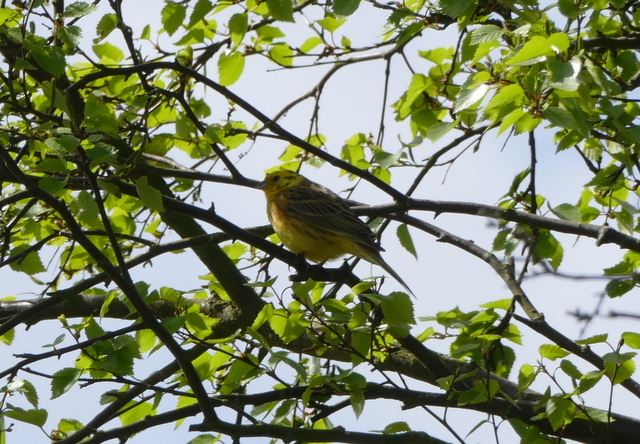 Yellowhammer – a bright yellow male
Yellowhammer – a bright yellow male
There were other birds to see as well – lots of Linnets, including some smart males with rusty backs and increasingly pink-toned breastst, and several bright yellow male Yellowhammers. Both species were once common farmland birds, but now seem to be more common on heaths, and coastal dunes in the case of Linnets. A pair of Bullfinch flew overhead, calling. A Goldcrest was elusive, singing amongst the trees, and a Tawny Owl heard hooting in the middle of the day was a bit of a surprise (though they seem to be doing this a lot more often at the moment).
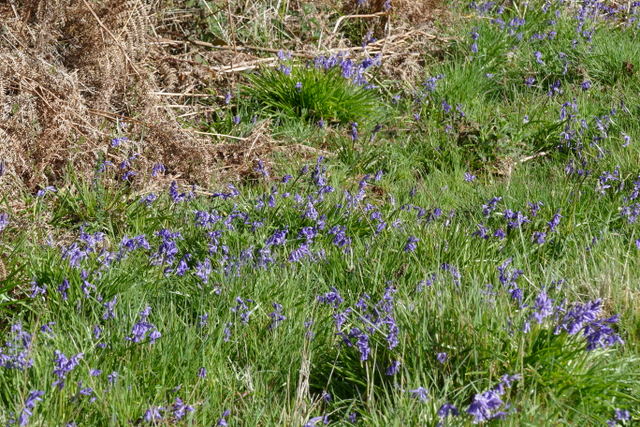 Bluebells – also in flower at the moment and looking beautiful
Bluebells – also in flower at the moment and looking beautiful
Eventually, we had to tear ourselves away from the heath and we headed down towards the coast. As we started to drop down off the ridge, a glance out of the side window of the car and we noticed five rather large shapes walking across a field. A quick stop and we were looking at a little herd of Red Deer, five hinds.
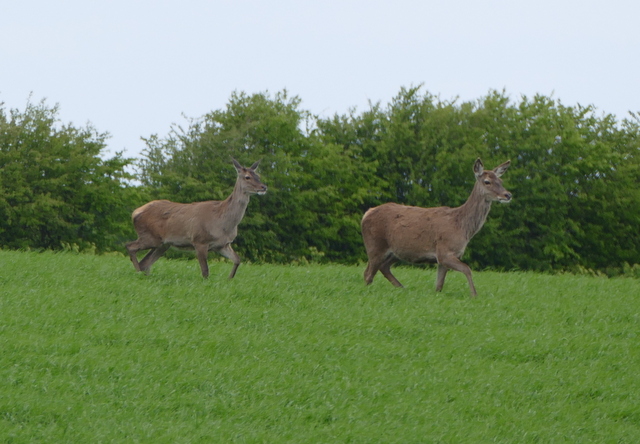 Red Deer – 2 of the 5 seen on our way down to the coast this morning
Red Deer – 2 of the 5 seen on our way down to the coast this morning
We decided to have a look at Kelling Water Meadow before lunch. There were more Whitethroats and Blackcaps singing along the lane, and lots of Goldfinches and Chaffinches. Unfortunately, there were no Yellow Wagtails today amongst the cows. But the pool held a nice summer-plumage Dunlin sporting a smart black belly patch and two Avocet, as well as the pair of Egyptian Geese together with their brood of goslings now seemingly reduced to two.
There were several Swallows hawking for insects over the pool when we arrived, but shortly afterwards a bigger group of Sand Martins appeared. We got great views of them, zooming back and forth low over the water. They seemed to have come in to bathe and, having splashed into the water, they landed on the fence close by to preen.
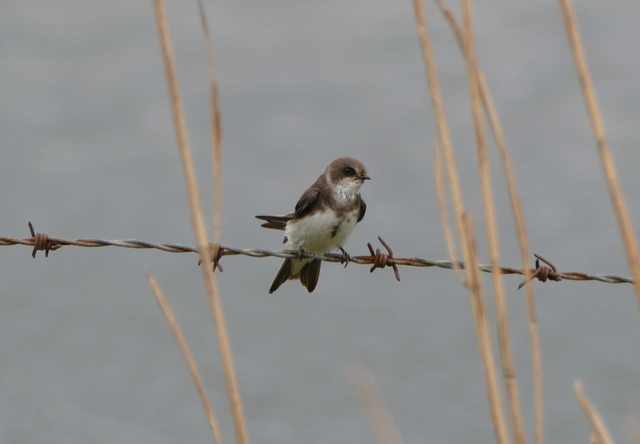 Sand Martin – preening on the fence at Kelling WM
Sand Martin – preening on the fence at Kelling WM
We were told about a Ring Ouzel seen earlier in the morning behind the beach on Weybourne Camp, so we decided to walk that way to take a look. A pair of Stonechat was feeding beside the path as we walked down towards the beach. They were not the only ones we saw here – a little further on, we came across another male Stonechat sporting some brightly coloured plastic rings. Ringed as a nestling on Kelling Heath in July 2012, he is getting on a bit in Stonechat terms!
Turning the corner by the beach, a scythe-winged shape appeared low over the hill in front of us. We just had time to get everyone onto it as it whizzed through and disappeared over towards the Water Meadow. A Hobby, it was probably after the local Swallows and Sand Martins. Along the front of Weybourne Camp, we found several Wheatears and a single Whimbrel feeding on the grass. But there was no sign of the Ring Ouzel – it was probably too disturbed now, with several walkers back and forth along the coast path.
It was time to head back for lunch, and as we turned round we could see a patch of dark cloud on the horizon. We were almost back to the car before it started to rain and thankfully it was just a quick shower.
By the time we got to Cley, the sky had cleared again and we were able to sit out on one of the picnic tables for lunch in the sunshine. While we were doing so, a shape appeared on the sedum roof of the Cley Marshes visitor centre behind us. A closer look revealed two Greenland Wheatears hopping about up there. The ‘green roof’ was obviously to their liking as a place to feed!
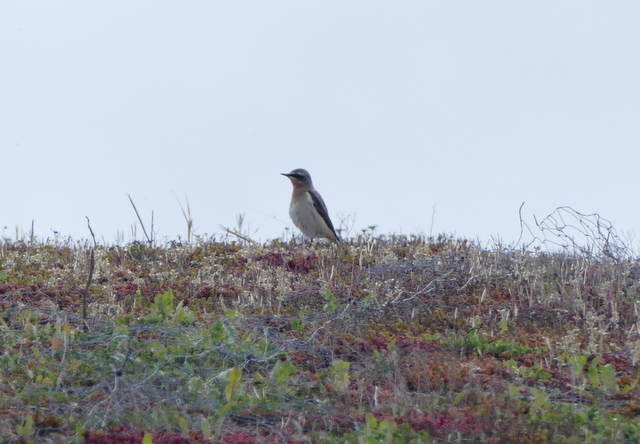 Greenland Wheatear – one of two feeding on the Cley visitor centre roof
Greenland Wheatear – one of two feeding on the Cley visitor centre roof
After lunch, we walked out onto the reserve. One or other of the pair of Marsh Harriers were circling over the reedbed most of the time we were there. We watched the male return with food but unfortunately, rather than make a food pass to the female in front of us, he dropped down into the reeds with it instead. Our second Hobby of the day circled over the hides. This time we got a much longer look at it, as it hawked for insects.
 Sedge Warbler – singing from the brambles by the path at Cley
Sedge Warbler – singing from the brambles by the path at Cley
We stopped to listen to a couple of Sedge Warblers singing by the path. Often rather confiding, they seemed to be a bit shy today, until one eventually performed for its audience. A Reed Warbler was singing from deep in the reeds on the way out to the hides, but we couldn’t see it. Thankfully, another Reed Warbler was slightly more accommodating, perching up and singing in the mostly-dead willows (killed by the Dec’13 storm surge) by the hides.
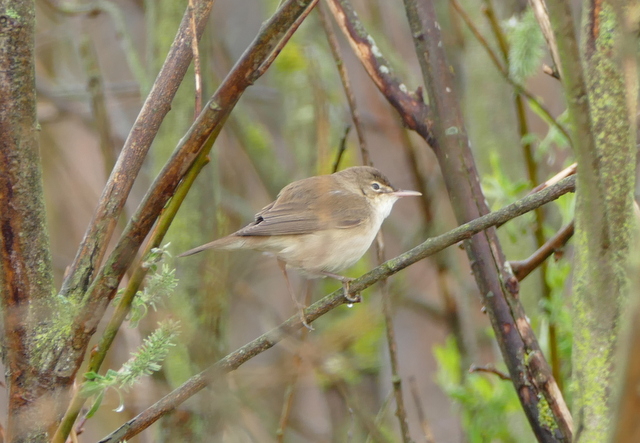 Reed Warbler – this one sat up obligingly, singing
Reed Warbler – this one sat up obligingly, singing
We could see more dark clouds approaching as we walked out to the hides. We got inside just in time, as it started to rain. This time, it rained hard for a time. In the hide, we were safely out of the weather but there was not much to see on the scrapes today. There were lots of Avocet, a nice group of Black-tailed Godwit and several Redshank, but no other waders apart from a couple of Little Ringed Plover which flew round and round high over the water and didn’t come in to land. There were lots of Shelduck, several Gadwall and a couple of Shoveler. A couple of Tufted Duck hid on one of the smaller pools and the odd Pochard flew over.
Eventually, the worst of the rain passed over and it lightened to drizzle. Only at that point did the Spoonbill appear. It was over on Billy’s Wash, but we could see it moving around through the reeds, occasionally raising its head – and ‘spoon’. Finally, it stopped to preen and we got a better look at it through the scope.
 Spoonbill – preening on Billy’s Wash in the drizzle
Spoonbill – preening on Billy’s Wash in the drizzle
We decided to walk back to the car and, while the weather was still feeling unhelpful, we drove round to the Eye Field. There were a couple more Wheatears on the posts along the road and another pair on the north side of the Eye Field, but no sign of anything else. With more rain arriving, we sat out the worst of it in the beach shelter for a few minutes, watching the Sandwich Terns flying back and forth offshore.
As it cleared again, we drove round to the East Bank. The grazing marsh towards Pope’s Marsh is looking really good at the moment, and we were not disappointed with the birds. We had not seen any Ruff on the main scrapes, and it quickly became apparent why. Four male Ruffs and a single female Reeve were feeding on the flooded grass, the males coming in to summer plumage and in various combinations of black, rusty and white plumage. It was a very good illustration of the amount of variation in this extremely variable species.
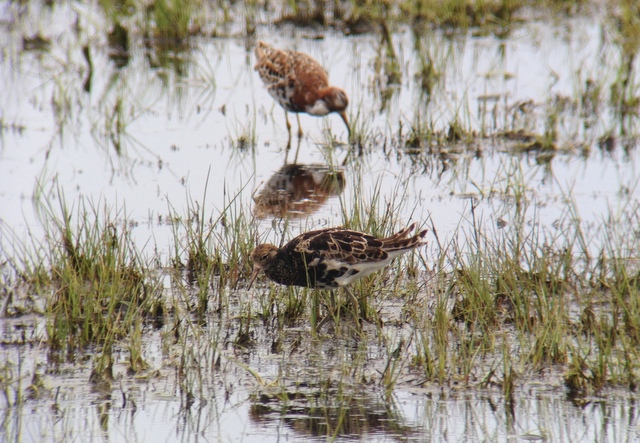 Ruff – four multi-coloured Ruffs and a Reeve were on Pope’s Marsh
Ruff – four multi-coloured Ruffs and a Reeve were on Pope’s Marsh
A quick scan revealed a very black-headed gull standing, partly concealed in the grass. Ironically, the commonest Black-headed Gulls have chocolate-coloured hoods in summer, so this was going to be something different. A closer look confirmed that it was a stunning adult Little Gull. It flew off before we could all get a good look at it through the scope, appearing to land over on Arnold’s Marsh, but thankfully reappeared back a few minutes later. As well as the small size, black hood, thin dark bill, grey and white upperwings and black underwings, we could see that it had a lovely light pink flush to its underparts. What a cracker!
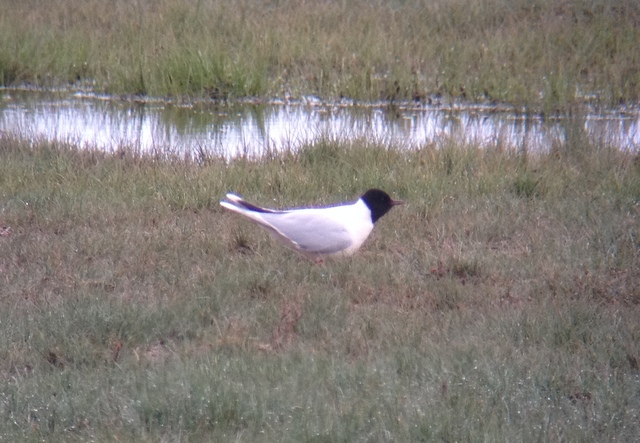 Little Gull – this very smart adult appeared on Pope’s Marsh between the rain
Little Gull – this very smart adult appeared on Pope’s Marsh between the rain
We walked on to Arnold’s Marsh. There were a few waders on show – a little flock of Dunlin, several Ringed Plover, a Curlew and a few Black-tailed Godwits, as well as the regular Redshank. Several Sandwich Terns were loafing around and more were flying over, calling loudly. A different call alerted us to the approach of a pair of adult Mediterranean Gulls. They flew in from the direction of Salthouse and almost overhead – we got a great view of their white wingtips, black hoods (not unlike the Little Gull in that respect) and bright red bills. Then, with another band of black cloud approaching, it was time to call it a day.
















